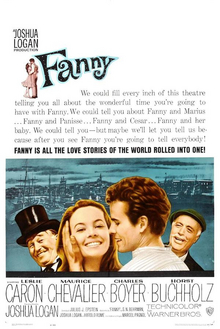Related Research Articles

Les Misérables, colloquially known as Les Mis or Les Miz, is a sung-through musical with music by Claude-Michel Schönberg, lyrics by Alain Boublil and Jean-Marc Natel, and a book by Schönberg and Boublil, based on the 1862 novel of the same name by Victor Hugo. The original French musical premiered in Paris in 1980 with direction by Robert Hossein. Its English-language adaptation by producer Cameron Mackintosh with lyrics by Herbert Kretzmer has been running in London since October 1985, making it the longest-running musical in the West End and the second longest-running musical in the world after the original Off-Broadway run of The Fantasticks.

Dame Mary Louise Webster,, known professionally as May Whitty and later, for her charity work, Dame May Whitty, was an English stage and film actress. She was one of the first two women entertainers to become a Dame. The British actors' union Equity was established in her home in 1930.

Fanny is a 1961 American Technicolor romantic drama film directed by Joshua Logan. The screenplay by Julius J. Epstein is based on the book for the 1954 stage musical of the same title by Logan and S.N. Behrman, which in turn had been adapted from Marcel Pagnol's trilogy. Pagnol wrote two plays, Marius (1929) and Fanny (1931) and completed the cycle by writing and directing a film, César, in 1936. Meanwhile, Marius (1931) and Fanny (1932) were also produced as films.

Una O'Connor was an Irish-born American actress who worked extensively in theatre before becoming a character actress in film and in television. She often portrayed comical wives, housekeepers and servants. In 2020, she was listed at number 19 on The Irish Times list of Ireland's greatest film actors.

The Arts Theatre is a theatre in Great Newport Street, in Westminster, Central London.

St Martin's Theatre is a West End theatre which has staged the production of The Mousetrap since March 1974, making it the longest continuous run of any show in the world.

Brice de Nice is a 2005 French surreal comedy-drama film directed by James Huth, written by Huth, Jean Dujardin, and Karine Angeli, and starring Dujardin. It is set in France, centering on the character Brice from Nice originally created by Dujardin for a stage sketch. A sequel to the film, Brice 3, was released on 19 October 2016 with the slogan "Parce que le 2, je l'ai cassé!"

Fanny is a musical with a book by S. N. Behrman and Joshua Logan and music and lyrics by Harold Rome. A tale of love, secrets, and passion set in and around the old French port of Marseille, it is based on Marcel Pagnol's trilogy of works titled Marius (1929), Fanny (1931), and César (1936).

Port of Seven Seas is a 1938 drama film starring Wallace Beery and featuring Frank Morgan and Maureen O'Sullivan. The movie was written by Preston Sturges based on the plays of Marcel Pagnol and the films based on them, and was directed by James Whale, the director of Frankenstein (1931) and The Invisible Man (1933). The cinematography is by Karl Freund, who filmed Fritz Lang's Metropolis (1927) and I Love Lucy (1951-1957).

Marius is a 1931 French drama film directed by Alexander Korda. It is based on the 1929 play of the same title by Marcel Pagnol. The film is a part of the Marseille Trilogy which includes the films Fanny and César. The film was selected to be screened in the Cannes Classics section of the 2015 Cannes Film Festival. The restored film was also given a limited re-release in the United States by Janus Films on 4 January 2017, first premiering at Film Forum.

John Peter Wearing is an Anglo-American theatre historian and professor, who has written numerous books and articles about nineteenth and twentieth-century drama and theatre, including The Shakespeare Diaries: A Fictional Autobiography, published in 2007. He has also written and edited well-received books on George Bernard Shaw, Arthur Wing Pinero, extensive reference series on the London theatre from 1890 to 1980, and theatrical biographies, among other subjects. As a professor of English literature, Wearing has specialised in Shakespeare and modern drama.

Marius Copil is a Romanian professional tennis player playing on the ATP World Tour and ATP Challenger Tour. He is a member of the Romanian Davis Cup team. Copil is known for his extremely fast, powerful, and consistent serve.

Éponine Thénardier, also referred to as the "Jondrette girl", is a fictional character in the 1862 novel Les Misérables by Victor Hugo.
Mary Tudor is a 1935 history play by the British writer Wilfrid Grantham. It portrays the reign of the Tudor Queen Mary I of England during the sixteenth century. Its West End run at the Playhouse Theatre lasted for 143 performances from 12 December 1935 to 18 April 1936. Flora Robson as Mary and Marius Goring as her husband Philip of Spain were particularly praised for their performances. The cast also included Torin Thatcher, Annie Esmond, Mary Hinton and Joyce Bland.

Marius is a 1929 play by the French writer Marcel Pagnol. It takes place in Marseilles, where a young man named Marius working in a café dreams of going to sea, his obsession eventually overcoming his developing romance with Fanny, a local girl.

Fanny is a 1931 play by the French writer Marcel Pagnol. It is the sequel to the 1929 play Marius and the second part in Pagnol's Marseilles trilogy.

The Last Straw is a 1937 comedy play by the British writers Reginald Denham and Edward Percy.

A Penny for a Song is a 1951 historical comedy play by the British writer John Whiting. In 1967 it was adapted into an opera of the same title by Richard Rodney Bennett, performed at Sadler's Wells.

The Moonraker is a historical play by the British writer Arthur Watkyn. It premiered at the Cambridge Arts Theatre and in June 1952 had a brief run at the Saville Theatre in London's West End. The cast included Jean Kent, Griffith Jones, Henry Oscar, Paul Whitsun-Jones, William Moore and Julian Somers. It was directed by Terence De Marney.

Longing for the Sea is a 1931 French-Swedish drama film directed by John W. Brunius and starring Edvin Adolphson, Carl Barcklind and Inga Tidblad. It is the Swedish-language version of the French film Marius directed by Alexander Korda and based on the 1929 play play of the same title by Marcel Pagnol. It was shot at the Joinville Studios in Paris and on location in Marseilles. The film's sets were designed by the art director Vincent Korda.
References
- ↑ Wearing p.129